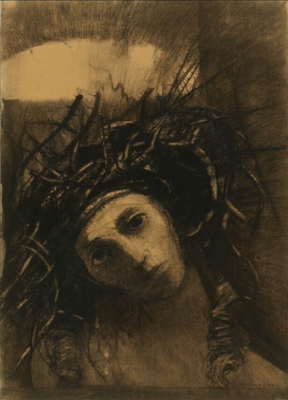Face to Face with Christ at the Royal Academy

Christ Crowned with Thorns by Odilon Redon - Wiki Image
Visiting the excellent Impressionists on Paper exhibition at the RA recently, I happened upon a truly arresting image: Christ Crowned with Thorns by Odilon Redon (1840-1916). This 1895 creation, comprising charcoal, black pastel and black crayon heightened with white on buff-gold paper, sees a beardless Christ's huge dark eyes meet ours from under a vast, unwieldy forest of thorns. The Medusa-like coiffure snakes anarchically and viciously in all directions. Here is Christ the Man of Sorrows bearing our sins with immense pathos and love. His head is cocked at an angle under the weight of his burden and his right eye is dilated with the pain but there is an absolute stillness and endurance in the image. An arc of light rising above the thorns, and the same hue as Christ's vivid pale face, suggests the comfort of the Resurrection.
The image chimes with medieval affective piety so resoundingly enacted by the crucified Christ suddenly raised on high to directly address the crowds in the Crucifixion pageant of the York Passion:
'Byholdes Myn heede, Myn handis and My feete,
And fully feele nowe, …
Yf any mournyng may be meete,
Or myscheve mesured unto Myne.'
Redon wrestled with the classic subject of Christ Crowned With Thorns in many other treatments and the thorns are always a redoubtable presence. Although he was not a Christian, Redon had a fascination with Christ, not least due to his dual essence: human and divine.
Redon belonged to the late nineteenth-century Symbolist movement. A reaction against Realism, Symbolism homed in on the spiritual reality underlying the material world.
Christ Crowned with Thorns is an example of Redon's celebrated 'noirs': spiritually infused works of charcoal or lithography executed in shades of black. But he also worked in colour and the RA exhibition contains two further Redon works which resonate colourfully with Christianity.
'The Golden Cell' (Profile of a Woman's Head) of 1892, composed of oil and coloured chalks with gold on paper, shows a woman in profile. Her eye is closed (in prayer? in pain?). Her face, hair and her top are all blue and she is surrounded almost entirely by gold. An interesting quasi-mandorla or oval shape is started by the curve of her veil which is completed by the incursion of a golden haze. The iconography evokes the Madonna and recalls the use of gold leaf in Byzantium and among the early Italian masters, among others.
A later 1904 work, Le vitrail (The Stained-glass Window) juxtaposes Redon's penchant for noir effects with a luminous, brightly coloured window, predominantly blue and gold, where some saintly figures can be hazily discerned. The capital of a column shows a mournful figure. The base of the next depicts another (possibly an angel) weeping black streams of tears and clasping a skull.
Redon is probably best known today for such dreamlike paintings which were inspired by Japanese art. His work is considered a precursor of surrealism.
In 1886, he exhibited his work with the Impressionists in their last exhibition. Redon had remained relatively unknown until the appearance in 1884 of the cult novel À rebours (Against Nature) by Joris-Karl Huysmans. The story features a decadent aristocrat who collected Redon's drawings which are characterised as mysterious and evocative:
'Those were the pictures bearing the signature: Odilon Redon. They held, between their gold-edged frames of unpolished pearwood, undreamed-of images. … Then there were charcoal sketches which delved even deeper into the terrors of fever-ridden dreams. ... These drawings defied classification; unheeding, for the most part, of the limitations of painting, they ushered in a very special type of the fantastic.'
Using sacramental language, Redon wanted to place 'the logic of the visible at the service of the invisible'. In his journal A Soi-même (To Myself) he adopts the Thomist eucharistic language of substance and accidents to describe this sacramental approach: 'I have often, as an exercise and as a sustenance, painted before an object down to the smallest accidents of its visual appearance; but the day left me sad and with an unsatiated thirst. The next day I let the other source run, that of imagination, through the recollection of the forms and I was then reassured and appeased.'
The art historian Michael Gibson writes that Redon began to want his works, even the ones darker in colour and subject matter, to portray the triumph of light over darkness. But at the same time, Redon described his work as ambiguous and undefinable: 'My drawings inspire, and are not to be defined. They place us, as does music, in the ambiguous realm of the undetermined.'
As for Huysmans and his scandalous novel À rebours which drew him into Decadent circles, he was told by Barbey d'Aurevilly that after writing the novel, he would have to choose between 'the muzzle of a pistol and the foot of the Cross.' Huysmans, who had received a secular education and abandoned his Catholic religion in childhood, returned to the Catholic Church eight years later. Later novels related his study of Catholicism and religious conversion.
This wonderful exhibition works charts how Impressionist and Post-Impressionist artists radically transformed the future direction of art not just through their paintings but also by lifting the status of works on paper - drawings, pastels, watercolours, temperas, gouaches - from something preparatory to artworks in their own right.
Impressionists on Paper continues at the Royal Academy until 10th March 2024.
LINK
Impressionists on Paper: www.royalacademy.org.uk/exhibition/impressionists-on-paper


















